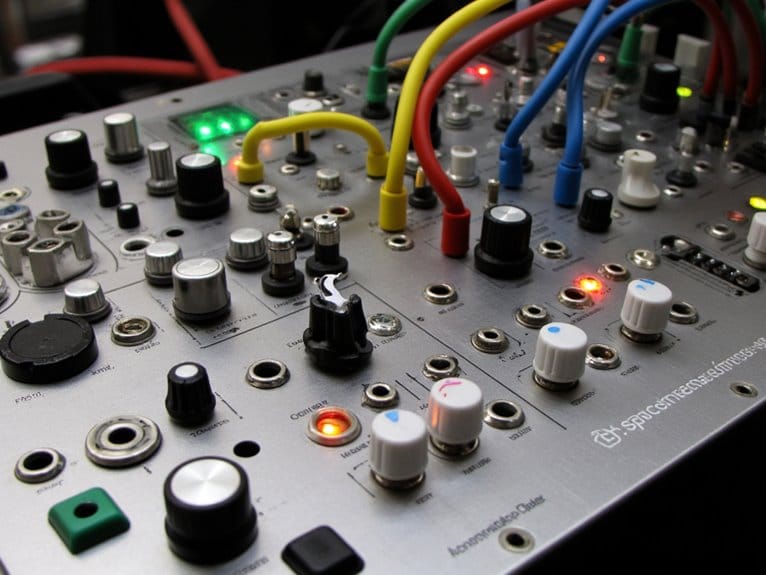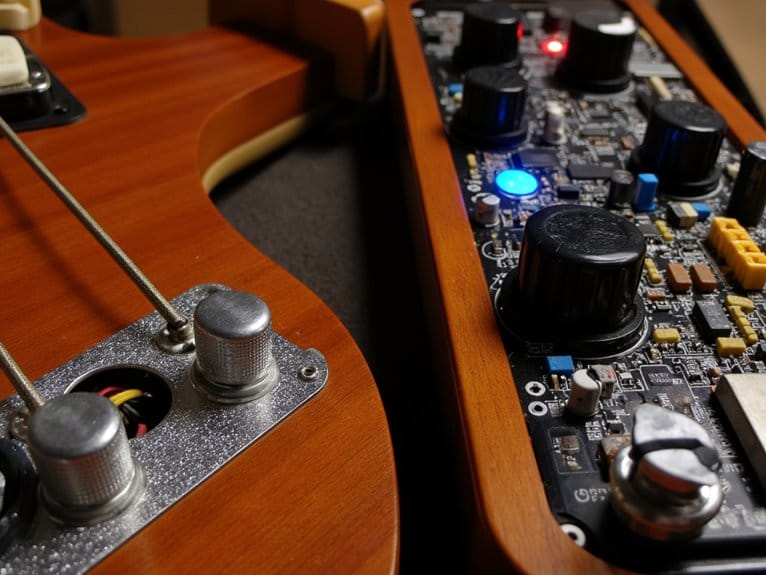Modular Synthesis: Patching Your Way to Unique Sounds
You’ll transform your approach to electronic music when you embrace modular synthesis, where patch cables replace preset limitations and each connection creates unique sonic possibilities. Starting with essential modules like oscillators, filters, and VCAs, you’ll route Control Voltage signals through physical cables to sculpt everything from gentle ambient textures to aggressive industrial soundscapes. This hands-on patching process, rooted in Robert Moog’s 1964 innovations and refined through modern Eurorack standards, turns your studio into a personalized laboratory where experimentation reveals techniques that’ll elevate your productions.
We are supported by our audience. When you purchase through links on our site, we may earn an affiliate commission, at no extra cost for you. Learn more.
Notable Insights
- Patch cables connect oscillators, filters, and modulators to create personalized instruments with unlimited sonic possibilities.
- Control Voltage routing allows one module to manipulate another, enabling dynamic sound evolution and complex modulations.
- Oscillators generate raw waveforms while filters sculpt timbre, forming the foundation for unique sound character.
- Semi-modular synthesizers offer accessible entry points with built-in connections and expandable patching capabilities for experimentation.
- Creative patching techniques like random voltage modulation and generative patches produce unpredictable, evolving soundscapes automatically.
The Building Blocks of Modular Sound Creation
When I first stepped into the world of modular synthesis, I’ll admit I was overwhelmed by the seemingly endless array of knobs, jacks, and blinking lights that confronted me-but understanding the essential building blocks quickly transformed that confusion into creative possibility.
You’ll need five fundamental components to create meaningful sounds: a sturdy case to house everything, oscillators that generate your primary waveforms, amplifiers to control signal strength, modulators like envelope generators for dynamic shaping, and output modules for audio routing.
The magic happens through module integration, where different oscillator types-whether analog VCOs, FM synthesizers, or wavetable modules-connect with filters, envelopes, and effects to create your unique sonic signature through careful patch cable routing. Semi-modular synthesizers offer an excellent entry point with their patch matrices featuring 50-93 connection points that allow basic operation without cables while providing extensive modular expansion possibilities. Understanding the difference between audio signals that carry sound and Control Voltage signals that transmit instructions between modules is crucial for effective patching and modulation.
From Moog to Eurorack: Evolution of Modular Systems
Understanding these building blocks provides the perfect foundation for exploring how modular synthesis has evolved from its groundbreaking origins to today’s thriving ecosystem.
When Robert Moog introduced the first commercial modular synthesizer in 1964, he revolutionized electronic music through voltage-controlled oscillators and patchable flexibility, though his massive systems remained expensive and complex.
The 1970 Minimoog shifted synthesis innovation toward accessibility, integrating essential components into a portable format that brought modular concepts to mainstream musicians.
Today’s Eurorack comparison reveals how we’ve returned to Moog’s original modular philosophy, but with standardized 3.5mm connections and affordable modules that encourage experimentation.
Modern semi-modular synthesizers like the Korg MS20 Mini bridge this gap by combining classic analog sound with patchable flexibility while maintaining the user-friendly approach that makes modular synthesis accessible to contemporary producers.
This evolution demonstrates how modular accessibility has transformed from academic curiosity to widespread sound design tool, maintaining the creative spirit Moog pioneered while serving modern electronic music production needs.
Essential Modules That Shape Your Sound
The heart of any modular system lies in five essential module types that work together to create, shape, and control your sound, and I’ve spent countless hours exploring how each one contributes to the sonic puzzle.
Understanding oscillator capabilities starts with recognizing that VCOs generate your raw waveforms-sine, sawtooth, square, and triangle-providing the foundational audio material.
Filter types like low-pass, high-pass, and band-pass sculpt your timbre by emphasizing or attenuating frequency bands, while VCA roles center on amplitude control for articulated notes.
Here’s how these modules interconnect for effective sound design:
- Envelope shaping controls your sound’s dynamic contour through ADSR parameters
- Modulation techniques using LFOs add movement and complexity to static tones
- Signal routing between modules creates evolving, expressive patches
Noise generators serve as valuable sound sources for creating textures and unpitched sounds that add random electrical components to your patches.
The Art of Physical Patching and Signal Flow
Every patch cable you connect transforms your modular synthesizer from a collection of individual modules into a living, breathing instrument, and I’ve discovered that mastering this physical connection process is where the real magic of modular synthesis begins. Through countless hours of experimentation, I’ve learned that effective patch cable techniques require understanding signal flow fundamentals, where your oscillators generate audio while LFOs and envelopes provide control voltage for signal modulation.
| Signal Source | Destination | Result |
|---|---|---|
| LFO Triangle Wave | Filter Cutoff | Sweeping Tonal Changes |
| Envelope Generator | VCA Control | Dynamic Note Shaping |
| Random Voltage | Oscillator Pitch | Unpredictable Melodies |
Each connection you make creates unique sonic possibilities, transforming static sounds into evolving textures that breathe with musical expression.
Unleashing Creative Potential Through Modular Flexibility
Beyond these fundamental patching concepts lies modular synthesis‘s most compelling advantage: an almost limitless capacity for creative exploration that I’ve found consistently surprises even experienced synthesists.
Your modular setup becomes a personalized laboratory where sonic experimentation flourishes through endless configuration possibilities, enabling you to craft timbres and textures impossible with conventional synthesizers.
The flexibility manifests in three key areas:
- Generative patches that evolve autonomously, creating continuously changing soundscapes without repetition
- Hybrid workflows combining hardware modules with software platforms like VCV Rack for expanded creative options
- Customizable signal routing that accommodates everything from meticulous studio sound design to spontaneous live performance
This adaptability encourages deep engagement with your instrument’s capabilities, fostering unique aesthetic approaches while building distinctive sound signatures through personalized patching configurations that reflect your individual creative vision.
On a final note
You’ve now got the roadmap to plunge into modular synthesis, from understanding basic oscillators and filters to mastering complex patch routing that’ll define your signature sound. While I won’t pretend the learning curve isn’t steep, the creative payoff you’ll experience makes every tangled cable worth it. Start small with a basic setup, experiment relentlessly, and you’ll discover sonic territories that traditional synths simply can’t reach.






